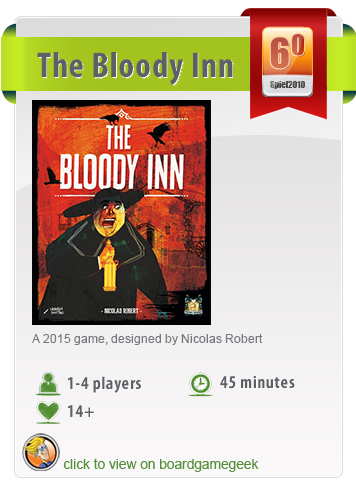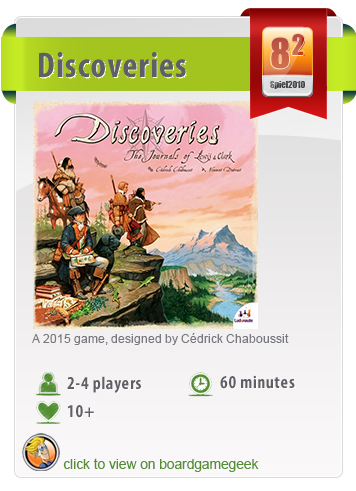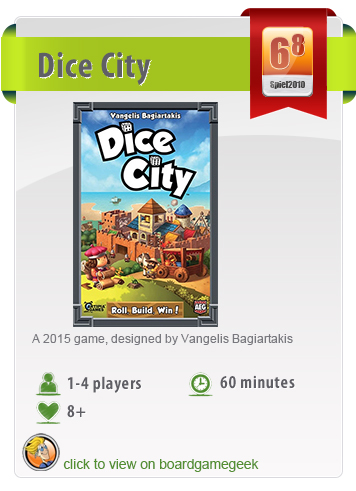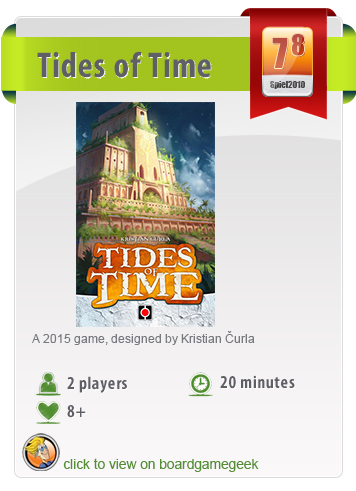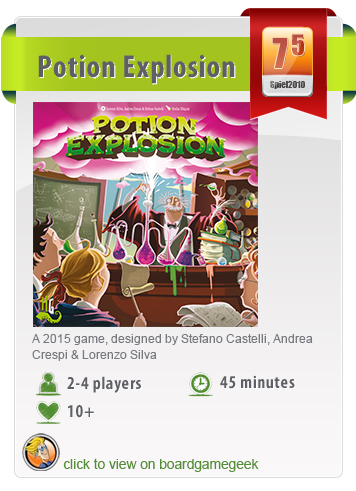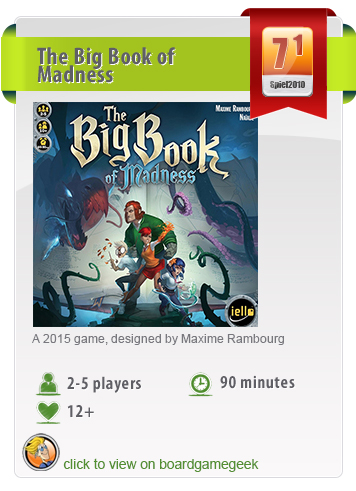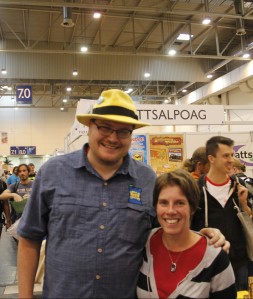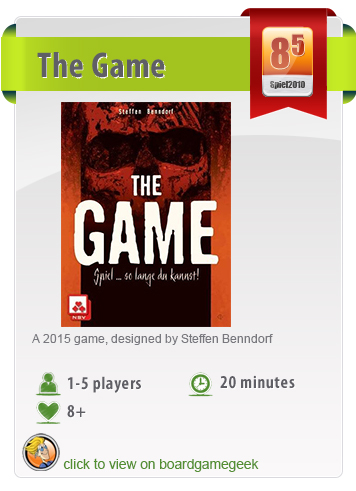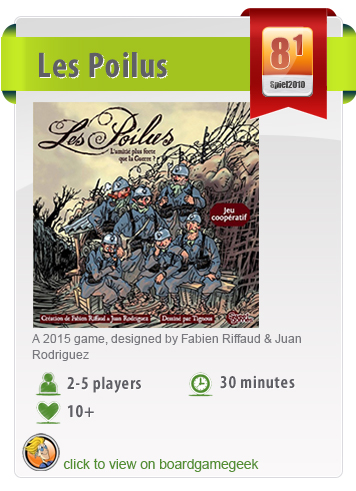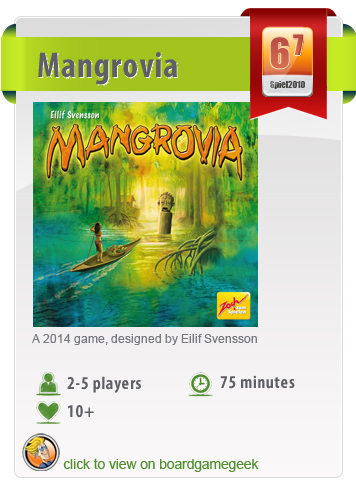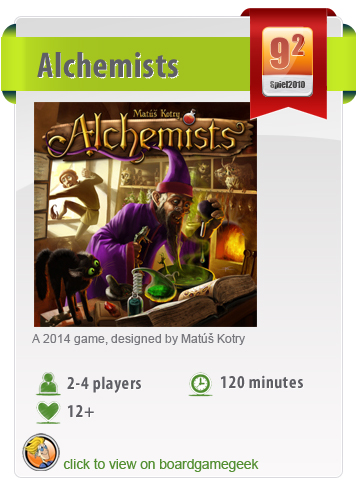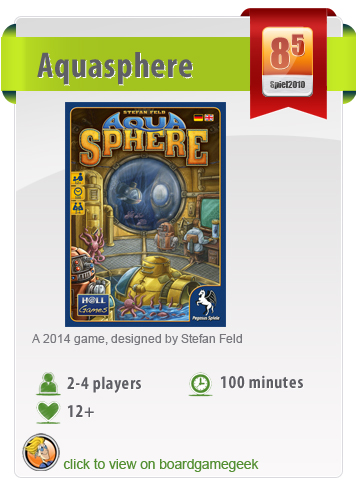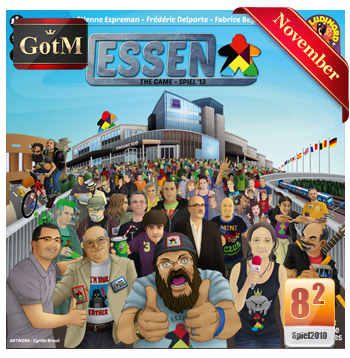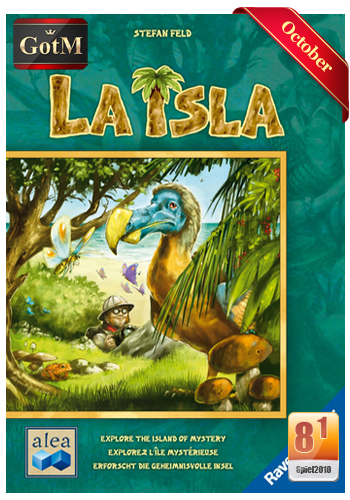(To view a bigger version of the pictures in the report, just click on them, and the will open in a new window.)
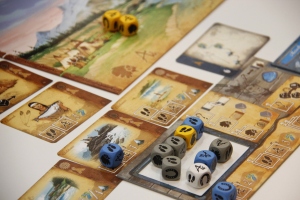 Sometimes I wonder why we’re going to Spiel every year. The amount of money we spent to visit the convention is quite a lot. Two nights in a hotel. Entrance fee for three days. Driving to Essen. Parking the car at the convention and buying some games. Having dinner for three evenings. If I add everything together, I come to a total of around $600. We got some nice deals at Spiel this year. But if I just add up the prices I would have to pay in the nearest store in town, with no discount or anything at all, I would come to a total of somewhere around $350. So why spend an extra $250?
Sometimes I wonder why we’re going to Spiel every year. The amount of money we spent to visit the convention is quite a lot. Two nights in a hotel. Entrance fee for three days. Driving to Essen. Parking the car at the convention and buying some games. Having dinner for three evenings. If I add everything together, I come to a total of around $600. We got some nice deals at Spiel this year. But if I just add up the prices I would have to pay in the nearest store in town, with no discount or anything at all, I would come to a total of somewhere around $350. So why spend an extra $250?
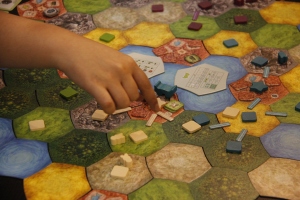 Just to see the newest games? No, not really. Nowadays there isn’t any reason to go to a convention to discover the newest thing, since we have the internet. To play the newest games? No, not really. There are more then enough gaming clubs in the area which will own the newest game pretty soon after an convention. On top of that, the annual fee for a club is lower then the cost of a single new game. The get some nice deals? No, not really. There are some nice deals at Spiel. But there are also nice deals in local game stores and in online shops. And as I’ve already mentioned, the additional costs for a convention are pretty big, so buying games is the last reason to visit one. If these are not legit reasons, why did we still go?
Just to see the newest games? No, not really. Nowadays there isn’t any reason to go to a convention to discover the newest thing, since we have the internet. To play the newest games? No, not really. There are more then enough gaming clubs in the area which will own the newest game pretty soon after an convention. On top of that, the annual fee for a club is lower then the cost of a single new game. The get some nice deals? No, not really. There are some nice deals at Spiel. But there are also nice deals in local game stores and in online shops. And as I’ve already mentioned, the additional costs for a convention are pretty big, so buying games is the last reason to visit one. If these are not legit reasons, why did we still go?
Well, that’s easy. The complete p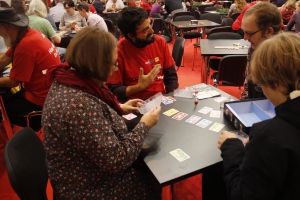 icture. The opportunity to see the newest games. The opportunity to play the newest games. The opportunity to smell the newest games. The opportunity to find some nice deals. And maybe just as important, to see the game from that small scale publisher. Coming from a country you didn’t know that it existed. their game to you. How big is the chance that you see that game in a local store? Or in an on-line store? And they are there. At the convention. Especially for you. To show their life-work to you. They want you to play their game. They want you to show you that they’ve developed that hidden gem you were looking for. They want you to buy their game. And therefore… They want to explain their game to you.
icture. The opportunity to see the newest games. The opportunity to play the newest games. The opportunity to smell the newest games. The opportunity to find some nice deals. And maybe just as important, to see the game from that small scale publisher. Coming from a country you didn’t know that it existed. their game to you. How big is the chance that you see that game in a local store? Or in an on-line store? And they are there. At the convention. Especially for you. To show their life-work to you. They want you to play their game. They want you to show you that they’ve developed that hidden gem you were looking for. They want you to buy their game. And therefore… They want to explain their game to you.
 The moment you’ve found a table with a game on it, that looks nice to you, is the moment where it all starts for the publisher. Do they let you struggle with the rulesbook, or are they going to explain how the game works to you? In most of the cases, they are happy to start and explain everything there is to know about the game. Before you know it, you’re playing the game. And maybe, if they did the job of explaining the game well enough, you enjoyed their game enough and you’re going to buy it. Leave your hard earned money at the booth, and take a new box home with you.
The moment you’ve found a table with a game on it, that looks nice to you, is the moment where it all starts for the publisher. Do they let you struggle with the rulesbook, or are they going to explain how the game works to you? In most of the cases, they are happy to start and explain everything there is to know about the game. Before you know it, you’re playing the game. And maybe, if they did the job of explaining the game well enough, you enjoyed their game enough and you’re going to buy it. Leave your hard earned money at the booth, and take a new box home with you.
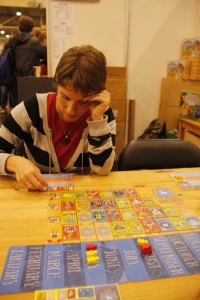 But the big thing we notice the last couple of years, is right behind the if. Do the job of explaining well enough. Explaining the rules of a game to somebody else is a hard job. If it’s too difficult, the players won’t remember all of the rules when you tell them. If it’s too easy, there is a big chance that there’s something forgotten while the game was explained. A tiny little rule. Tiny, but very important in the most cases, because the little rules can make or break the game. To us it seems, the last couple of years the look of the games which are showed are getting better and better. But on the other hand, the explanation of the rules is getting worse and worse. You might think, that when the designer of the game is explaining the game to you, nothing could go wrong. Well, it can. On the last day, we were able to play the game Samara. It was explained to us by the designer. Lucky us, he was also Dutch, thus there was no language problem at all. While the designer was explaining, it looked to us, if he was bored by explaining the game. When we had a question he barely managed to suppress a sigh. What was ‘difficult’ to us, was just so logical to him. We played the game, didn’t dislike it, but we were missing something in it. While we were playing the game, we just did the same trick over and over again. We had the feeling that some tiny rules were forgotten. Some tiny rules that could have improve the game.
But the big thing we notice the last couple of years, is right behind the if. Do the job of explaining well enough. Explaining the rules of a game to somebody else is a hard job. If it’s too difficult, the players won’t remember all of the rules when you tell them. If it’s too easy, there is a big chance that there’s something forgotten while the game was explained. A tiny little rule. Tiny, but very important in the most cases, because the little rules can make or break the game. To us it seems, the last couple of years the look of the games which are showed are getting better and better. But on the other hand, the explanation of the rules is getting worse and worse. You might think, that when the designer of the game is explaining the game to you, nothing could go wrong. Well, it can. On the last day, we were able to play the game Samara. It was explained to us by the designer. Lucky us, he was also Dutch, thus there was no language problem at all. While the designer was explaining, it looked to us, if he was bored by explaining the game. When we had a question he barely managed to suppress a sigh. What was ‘difficult’ to us, was just so logical to him. We played the game, didn’t dislike it, but we were missing something in it. While we were playing the game, we just did the same trick over and over again. We had the feeling that some tiny rules were forgotten. Some tiny rules that could have improve the game.
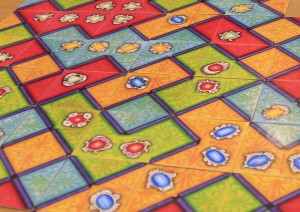 Good thing there are also small publishers like F-Hein who know that’s important to explain the rules properly. We visit the small booth of this German publisher every year, and it’s always a pleasure when the owner (and designer) sits down at your table and explain the game to you. Clear, and nothing is forgotten. When he’s done, you’re be able to fully enjoy the game. When you’re finished playing, you just want to buy the game. And then you discover the other problem of this small publishing house. The price. All of his game, are on the high end scale of what the game is worth. Which results in saying thank you and leaving the booth. Without the game and hoping that someday, you can buy the game for a nice deal. But in the back of your mind, you know that’s not going to happen, because you’re never see their games in any store.
Good thing there are also small publishers like F-Hein who know that’s important to explain the rules properly. We visit the small booth of this German publisher every year, and it’s always a pleasure when the owner (and designer) sits down at your table and explain the game to you. Clear, and nothing is forgotten. When he’s done, you’re be able to fully enjoy the game. When you’re finished playing, you just want to buy the game. And then you discover the other problem of this small publishing house. The price. All of his game, are on the high end scale of what the game is worth. Which results in saying thank you and leaving the booth. Without the game and hoping that someday, you can buy the game for a nice deal. But in the back of your mind, you know that’s not going to happen, because you’re never see their games in any store.
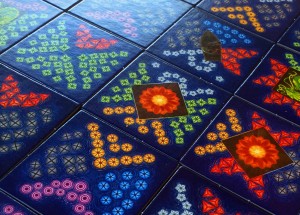 It also can worse. What about somebody explaining a game to you that looks so beautiful and fun to you. Just when you think you can play the game, he tells you that he likes the game so much, that he also wants to play it and is going to join you playing the game. You prefer to play the game without him. But you’ve got manners, so you don’t refuse. While you’re playing, there’s a situation at the table. A couple of rounds later, the same situations is on the table, but not it’s the turn of the guy who just explained the game to you. At that moment he says something like: “I completely forgot to tell you about this, but this and that is the rule when this happens.” Right after saying that, he’s taking advantage with the newly added rule to the game. Such things can happen once, even twice during a game. But after the third time, you’re getting annoyed by it. You just want to finish the game as soon as possible. But as said, you’ve got manners, and you keep playing. And just at that moment you discover that it even can get worse, as the guy who was explaining the game, is cheating in playing. At that point, it’s hard to keep on playing like nothing is happened. You just look at the other side of the table and know that she also noticed the cheating. At that moment you just know that this is an instant no-buy. No matter how nice the price might be. You even don’t want to know it. But you’re happy that you can look through all the shortcomings of the play and you like the game. And someday you might find it for a nice deal, and think back to that horrible experience of the first play.
It also can worse. What about somebody explaining a game to you that looks so beautiful and fun to you. Just when you think you can play the game, he tells you that he likes the game so much, that he also wants to play it and is going to join you playing the game. You prefer to play the game without him. But you’ve got manners, so you don’t refuse. While you’re playing, there’s a situation at the table. A couple of rounds later, the same situations is on the table, but not it’s the turn of the guy who just explained the game to you. At that moment he says something like: “I completely forgot to tell you about this, but this and that is the rule when this happens.” Right after saying that, he’s taking advantage with the newly added rule to the game. Such things can happen once, even twice during a game. But after the third time, you’re getting annoyed by it. You just want to finish the game as soon as possible. But as said, you’ve got manners, and you keep playing. And just at that moment you discover that it even can get worse, as the guy who was explaining the game, is cheating in playing. At that point, it’s hard to keep on playing like nothing is happened. You just look at the other side of the table and know that she also noticed the cheating. At that moment you just know that this is an instant no-buy. No matter how nice the price might be. You even don’t want to know it. But you’re happy that you can look through all the shortcomings of the play and you like the game. And someday you might find it for a nice deal, and think back to that horrible experience of the first play.
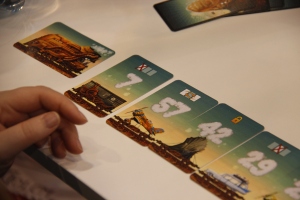 This year we’ve played 22 different games at Spiel. I think 20 of them were explained to us. And of the games that were explained to us, about 15 were explained badly to us. I know explaining the game to somebody else is hard. From experience I know you have to look at it as it’s a job. You’ll have to know the product from beginning to start. Of course it’s easier when you like the product yourself then when you think of it as an so-so-game. Also the better you know the rules, the less nervous you are about forgetting one of those tiny little rules. To me it seems that people explaining games at Spiel most of the time don’t see it as a job. They see it as a way to get to the convention for free and in return for that, they have to explain a game every now and then. And of course, most of the time the people aren’t getting paid for explaining the game, they are happy if they get a copy of the game for free. But still, if you accept the challenge to explain the game, you have to do it like it’s your daytime job.
This year we’ve played 22 different games at Spiel. I think 20 of them were explained to us. And of the games that were explained to us, about 15 were explained badly to us. I know explaining the game to somebody else is hard. From experience I know you have to look at it as it’s a job. You’ll have to know the product from beginning to start. Of course it’s easier when you like the product yourself then when you think of it as an so-so-game. Also the better you know the rules, the less nervous you are about forgetting one of those tiny little rules. To me it seems that people explaining games at Spiel most of the time don’t see it as a job. They see it as a way to get to the convention for free and in return for that, they have to explain a game every now and then. And of course, most of the time the people aren’t getting paid for explaining the game, they are happy if they get a copy of the game for free. But still, if you accept the challenge to explain the game, you have to do it like it’s your daytime job.
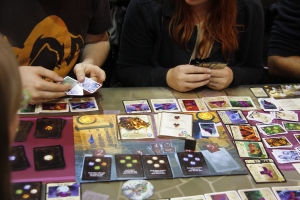 The first two days we were at Spiel, we saw a lot of tables on which The Big Book of Madness was played. Didn’t hear of it before, but the game looked nice to us and we wanted to play a game. But every time we passed the booth, none of the tables were free or the games that were played weren’t close to get finished. On Sunday, we decided to do something we never did before. When the doors of the convention opened at 9:55AM, we walked to the booth as fast as we could. And Yes! We were lucky. There was one table free with the game on it. We sat do
The first two days we were at Spiel, we saw a lot of tables on which The Big Book of Madness was played. Didn’t hear of it before, but the game looked nice to us and we wanted to play a game. But every time we passed the booth, none of the tables were free or the games that were played weren’t close to get finished. On Sunday, we decided to do something we never did before. When the doors of the convention opened at 9:55AM, we walked to the booth as fast as we could. And Yes! We were lucky. There was one table free with the game on it. We sat do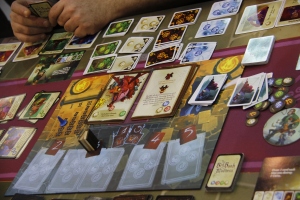 wn and started to read the rules. But in fact I hoped that somebody would explain the game to us, as it was a twelve page rulebook. In the meantime a French couple from Lille joined us at the table. While reading the rules, I learned that this was a cooperative game. Nice. After I’ve globally read the rules, so that I knew what terminology was used, I knew that there were a lot of little tiny rules. I started to read the rules again, as nobody had time to explain the game to us. The other couple was patient with me, and just when I was close to finish the rules, somebody showed up at our table, asking if he should explain to us, what was going on our table? Happily I said yes, as I was convinced that I would forget the tiny little rules, and it wasn’t my fault if somebody else did it when he was explaining. The guy asked if he should explain the game in German or in English.
wn and started to read the rules. But in fact I hoped that somebody would explain the game to us, as it was a twelve page rulebook. In the meantime a French couple from Lille joined us at the table. While reading the rules, I learned that this was a cooperative game. Nice. After I’ve globally read the rules, so that I knew what terminology was used, I knew that there were a lot of little tiny rules. I started to read the rules again, as nobody had time to explain the game to us. The other couple was patient with me, and just when I was close to finish the rules, somebody showed up at our table, asking if he should explain to us, what was going on our table? Happily I said yes, as I was convinced that I would forget the tiny little rules, and it wasn’t my fault if somebody else did it when he was explaining. The guy asked if he should explain the game in German or in English. 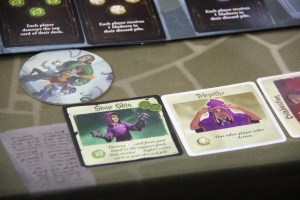 The four of us chose English and the guy started explaining the game in a way if never experienced before. He started to tell the story, the theme of the game. But he did that in such a great way, that you were sucked into the game. You really felt like you were part of the game. After he explained the story, he started to explain the rules. All of them. Nothing was forgotten. He was telling everything in such a way, that it just made it all logical and everything you was thinking is “I want to play this great game!” In about 20 minutes, this guy changed the job of explanation into something completely different. Something I would call: “The Art of Explaining“.
The four of us chose English and the guy started explaining the game in a way if never experienced before. He started to tell the story, the theme of the game. But he did that in such a great way, that you were sucked into the game. You really felt like you were part of the game. After he explained the story, he started to explain the rules. All of them. Nothing was forgotten. He was telling everything in such a way, that it just made it all logical and everything you was thinking is “I want to play this great game!” In about 20 minutes, this guy changed the job of explanation into something completely different. Something I would call: “The Art of Explaining“.

